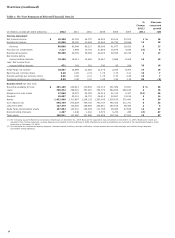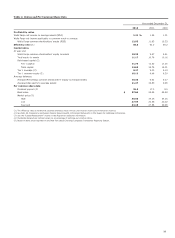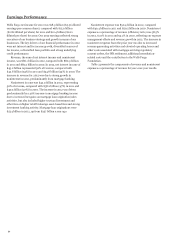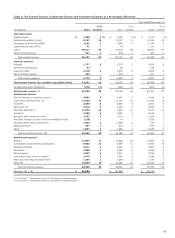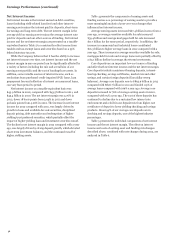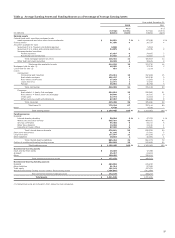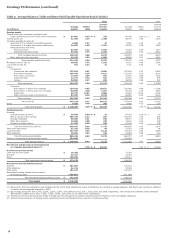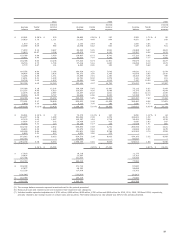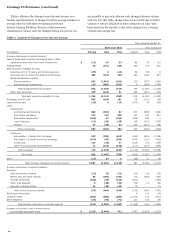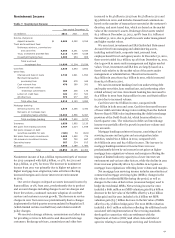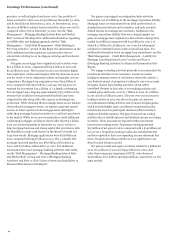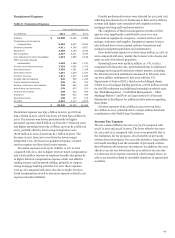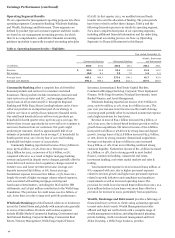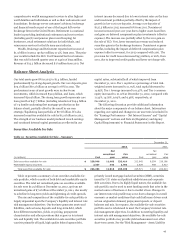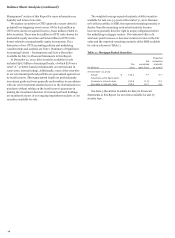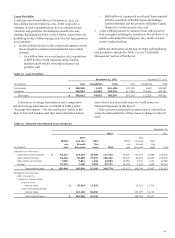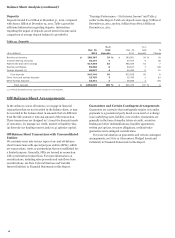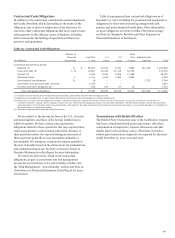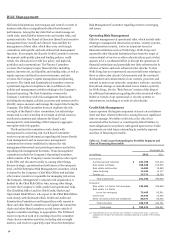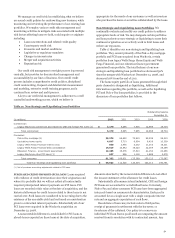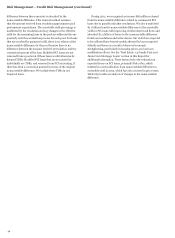Wells Fargo 2012 Annual Report Download - page 44
Download and view the complete annual report
Please find page 44 of the 2012 Wells Fargo annual report below. You can navigate through the pages in the report by either clicking on the pages listed below, or by using the keyword search tool below to find specific information within the annual report.Earnings Performance (continued)
practices, as well as higher foreclosure costs. Our portfolio of
loans serviced for others was $1.91 trillion at December 31, 2012,
and $1.85 trillion at December 31, 2011. At December 31, 2012,
the ratio of MSRs to related loans serviced for others was 0.67%,
compared with 0.76% at December 31, 2011. See the “Risk
Management – Mortgage Banking Interest Rate and Market
Risk” section of this Report for additional information regarding
our MSRs risks and hedging approach and the “Risk
Management – Credit Risk Management –Risks Relating to
Servicing Activities” section in this Report for information on the
DOJ settlement and the regulatory consent orders that we
entered into relating to our mortgages servicing and foreclosure
practices.
Net gains on mortgage loan origination/sale activities were
$10.3 billion in 2012, compared with $4.6 billion in 2011 and
$6.4 billion in 2010. The increase in 2012 was driven by higher
loan origination volume and margins while the decrease in 2011
was the result of lower origination volume and margins on loan
originations. Mortgage loan originations were $524 billion in
2012, compared with $357 billion a year ago. During 2012 we
retained for investment $19.4 billion of 1-4 family conforming
first mortgage loans, forgoing approximately $575 million of fee
revenue that could have been generated had the loans been
originated for sale along with other agency conforming loan
production. While retaining these mortgage loans on our balance
sheet reduced mortgage revenue, we expect to generate spread
income in future quarters from mortgage loans with higher
yields than mortgage-backed securities we could have purchased
in the market. While we do not currently plan to hold additional
conforming mortgages on balance sheet (other than $3.3 billion
from our unclosed pipeline at December 31, 2012), we have a
large mortgage business and strong capital that provides us with
the flexibility to make such choices in the future to benefit our
long-term results. Mortgage applications were $736 billion in
2012, compared with $537 billion in 2011. The 1-4 family first
mortgage unclosed pipeline was $81 billion at December 31,
2012, and $72 billion at December 31, 2011. For additional
information about our mortgage banking activities and results,
see the “Risk Management – Mortgage Banking Interest Rate
and Market Risk” section and Note 9 (Mortgage Banking
Activities) and Note 17 (Fair Values of Assets and Liabilities) to
Financial Statements in this Report.
Net gains on mortgage loan origination/sales activities
include the cost of additions to the mortgage repurchase liability.
Mortgage loans are repurchased from third parties based on
standard representations and warranties, and early payment
default clauses in mortgage sale contracts. Additions to the
mortgage repurchase liability that were charged against net
gains on mortgage loan origination/sales activities during 2012
totaled $1.9 billion (compared with $1.3 billion for 2011), of
which $1.7 billion ($1.2 billion for 2011) was for subsequent
increases in estimated losses on prior period loan sales. For
additional information about mortgage loan repurchases, see the
“Risk Management – Credit Risk Management – Liability for
Mortgage Loan Repurchase Losses” section and Note 9
(Mortgage Banking Activities) to Financial Statements in this
Report.
We engage in trading activities primarily to accommodate the
investment activities of our customers, execute economic
hedging to manage certain of our balance sheet risks and for a
very limited amount of proprietary trading for our own account.
Net gains (losses) from trading activities, which reflect
unrealized changes in fair value of our trading positions and
realized gains and losses, were $1.7 billion in 2012, $1.0 billion
in 2011 and $1.6 billion in 2010. The year-over-year increase in
trading activities in 2012 was driven by gains on customer
accommodation trading activities and economic hedging gains,
which included higher gains on deferred compensation plan
investments based on participant elections (offset entirely in
employee benefits expense). Net gains (losses) from trading
activities do not include interest and dividend income on trading
securities. Those amounts are reported within net interest
income from trading assets. Proprietary trading generated
$15 million of net gains in 2012, compared with a $14 million net
loss in 2011. Proprietary trading results also included interest
and fees reported in their corresponding income statement line
items. Proprietary trading activities are not significant to our
client-focused business model.
Net gains on debt and equity securities totaled $1.4 billion for
2012, $1.5 billion for 2011 and $455 million for 2010, after
other-than-temporary impairment (OTTI) write-downs of
$416 million, $711 million and $940 million, respectively, for the
same periods.
42


